More Interventions, Low Adoption: To What Extent Are the Existing Seed Sources to Blame? The Case of Orange Fleshed Sweet Potato in Central and Northern Malawi
Abstract
1. Introduction
Sweet Potato Seed Systems
2. Materials and Methods
2.1. Study Area and Data
2.2. Theoretical and Conceptual Frameworks
2.3. Estimation Strategy and Empirical Model
2.3.1. Effect of the Existing Sources of Vines on Adoption of OFSP
2.3.2. Effect of the Existing Sources of Vines on Seed Security of Sweet Potato Farmers
3. Results
3.1. Descriptive Results
3.1.1. Awareness, Adoption, and Intensity of Adoption of OFSP
3.1.2. The Existing Sources of Vines
The Existing Sources of Vines and Farmers’ Seed Security
3.2. Household’s Socio-Economic, Demographic, Institutional Characteristics
3.3. Empirical Results
3.3.1. The Triple Hurdle Estimates of the Determinants of Adoption of OFSP among Smallholder Farmers
3.3.2. The Existing Sources of Vines and Farmers’ Seed Security Experience Score
4. Discussion
4.1. Effect of the Existing Sources of Vines on the Adoption of Orange Fleshed Sweet Potato
4.2. The Existing Sources of Vines and Farmers’ Seed Security Status
5. Conclusions
Author Contributions
Funding
Institutional Review Board Statement
Informed Consent Statement
Data Availability Statement
Acknowledgments
Conflicts of Interest
References
- Woolfe, J.A. Sweet Potato: An Untapped Food Resource; Cambridge University Press: Cambridge, UK, 1992. [Google Scholar]
- FAOSTAT. Production and Area Harvested Statistics for Sweet Potato. 2020. Available online: https://data.un.org/Data.aspx?d=FAO&f=itemCode%3A122 (accessed on 1 February 2022).
- CIP. Unleashing the Potential of Sweet Potato in SubSaharan Africa: Current Challenges and Way Forward, Social Sciences, Working Paper No.2009-1, 2009. CIP/WorkingPaper. Available online: https://cgspace.cgiar.org/handle/10568/108748 (accessed on 2 March 2022).
- CIP. Commercialization of Orange-Fleshed Sweetpotato Based Products in Malawi. 2007. Available online: https://www.sweetpotatoknowledge.org/wp-content/uploads/2017/10/SPHI17-Commercialization-of-Orange-fleshed-sweetpotato-products-in-Malawi.pdf (accessed on 2 March 2022).
- Bovell-Benjamin, A.C. Sweet potato: A review of its past, present, and future role in human nutrition. Adv. Food Nutr. Res. 2007, 52, 1–59. [Google Scholar] [PubMed]
- Yang, J.; Moeinzadeh, M.H.; Kuhl, H.; Helmuth, J.; Xiao, P.; Haas, S.; Liu, G.; Zheng, J.; Sun, Z.; Fan, W. Haplotype-resolved sweet potato genome traces back its hexaploidization history. Nat. Plants 2017, 3, 696–703. [Google Scholar] [CrossRef] [PubMed]
- Chipungu, F. Ethno-Botanic and Genetic Variations among Sweetpotato Accessions Grown in Malawi. Ph.D. Thesis, University of Malawi, Chancellor College, Zomba, Malawi, 2008. [Google Scholar]
- Moyo, C.; Benesi, I.; Chipungu, F.; Mwale, C.; Sandifolo, V.; Mahungu, N. Cassava and sweet potato yield assessment in Malawi. Afric. Crop Sci. J. 2004, 12, 295–303. [Google Scholar]
- Chipungu, F.; Changadeya, W.; Ambali, A.; Saka, J.; Mahungu, N.; Mkumbira, J. Adaptation of sweet potato [Ipomoea batatas) (L.) Lam] genotypes in various agro-ecological zones of Malawi. Afr. J. Biotechnol. 2018, 17, 531–540. [Google Scholar]
- Low, J.W.; Ortiz, R.; Vandamme, E.; Andrade, M.; Biazin, B.; Grüneberg, W.J. Nutrient-Dense Orange-Fleshed Sweetpotato: Advances in Drought-Tolerance Breeding and Understanding of Management Practices for Sustainable Next-Generation Cropping Systems in Sub-Saharan Africa. Front. Sustain. Food Syst. 2020, 4, 50. [Google Scholar] [CrossRef]
- FAOSTAT. Production and Area Harvested Statistics for Sweet Potato in 2019. Available online: https://data.un.org/Data.aspx?d=FAO&f=itemCode%3A122 (accessed on 10 February 2021).
- United Nations. The Sustainable Development Goals Report. United Nations Publications, Department of Economic and Social Affairs. 2020. Available online: https://sdgs.un.org/publications/sustainable-development-goals-report-2020-24686 (accessed on 1 February 2022).
- FAO. The State of Food Security and Nutrition in the World: Building Climate Resilience for Food Security and Nutrition; Food and Agriculture Organization of the United Nations: Rome, Italy, 2018; Available online: https://www.fao.org/documents/card/en/c/I9553EN (accessed on 1 February 2022).
- Beal, T.; Massiot, E.; Arsenault, J.E.; Smith, M.R.; Hijmans, R. Global trends in dietary micronutrient supplies and estimated prevalence of inadequate intakes. PLoS ONE 2017, 12, e0175554. [Google Scholar] [CrossRef] [PubMed]
- Low, J.; Arimond, M.; Osman, N.; Cunguara, B.; Zano, F.; Tschirley, D. A food-based approach introducing orange fleshed sweet potatoes increased vitamin A intake and serum retinol concentrations in young children in rural Mozambique. J. Nutr. 2007, 137, 1320–1327. [Google Scholar] [CrossRef]
- Low, J.; Mwanga, R.; Andrade, M.; Carey, E.; Ball, A. Tackling vitamin A deficiency with biofortified sweetpotato in sub-Saharan Africa. Glob. Food Sec. 2017, 14, 23–30. [Google Scholar] [CrossRef]
- Webb, G.A.; Grant, F.; Watkinson, M.; Okuku, H.S.; Wanjala, R.; Cole, D.; Levin, C.; Low, J. Promotion of orange fleshed sweet potato increased vitamin a intakes and reduced the odds of low retinol-binding protein among postpartum Kenyan women. J. Nutr. 2017, 147, 955–963. [Google Scholar]
- Naico, A.; Lusk, J. The value of a nutritionally enhanced staple crop: Results from a choice experiment conducted with orange-fleshed sweet potatoes in Mozambique. J. Afr. Econ. 2010, 19, 536–558. [Google Scholar] [CrossRef]
- Gilligan, D.O. Biofortification, agricultural technology adoption, and nutrition policy: Some lessons and emerging challenges. Econ. Stud. 2012, 58, 405–421. [Google Scholar] [CrossRef]
- Mitra, S. Nutritional Status of Orange-fleshed Sweetpotato in Alternating of Malnutrition through a Food-Based Approach. Nutr. Food Sci. 2012, 2, 8. [Google Scholar] [CrossRef]
- Andrade, M.; Ricardo, J.; Naico, A.; Alvaro, A.; Makunde, G.; Low, J.; Ortiz, R.; Gruneberg, W.J. Release of orange-fleshed sweetpotato (Ipomoea batatas [l.] Lam.) cultivars in Mozambique through an accelerated breeding scheme. J. Agric. Sci. 2016, 155, 919–929. [Google Scholar] [CrossRef]
- Gatto, M.; Okello, J.; Pradel, W.; Kwikiriza, N.; Mgomezulu, W.; Nyirenda, Z.; Okuku, H.; Suarez, V.; Van Vugt, D.; Chipungu, F.; et al. Adoption and Effects of Orange-fleshed Sweetpotato Varieties in Malawi; International Potato Center: Lima, Peru, 2021. Available online: https://cgspace.cgiar.org/handle/10568/112937 (accessed on 21 January 2022).
- Government of Malawi. National Agricultural Investment Plan. 2018. Available online: https://www.scotland-malawipartnership.org/ (accessed on 29 September 2021).
- McEwan, M.A.; Almekinders, C.J.M.; Andrade-Piedra, J.J.L.; Garrett, K.A.; Kumar, L.; Mayanja, S.; Omondi, B.A.; Srinivasulu Rajendran, S.; Thiele, G. “Breaking through the 40% adoption ceiling: Mind the seed system gaps.” A perspective on seed systems research for development in One CGIAR. Outlook Agric. 2021, 50, 5–12. [Google Scholar] [CrossRef] [PubMed]
- Kilwinger, F.B.M.; Marimo, P.; Rietveld, A.M.; Almekinders, C.J.M.; Van Dam, Y.K. Not only the seed matters: Farmers’ perceptions of sources for banana planting materials in Uganda. Outlook Agric. 2020, 49, 119–132. [Google Scholar] [CrossRef]
- Harrison, H.F.; Jackson, D.M. Response of two sweet potato cultivars to weed interference. Crop Prot. 2011, 30, 1291–1296. [Google Scholar] [CrossRef]
- Bentley, J.W.; Andrade-Piedra, J.; Demo, P.; Dzomeku, B.; Jacobsen, K.; Kikulwe, E.; Kromann, P.; Kumar, L.; McEwan, E.; Mudege, N.; et al. Understanding root, tuber, and banana seed systems and coordination breakdown: A multi-stakeholder framework. Crop Improv. 2018, 32, 599–621. [Google Scholar] [CrossRef]
- Jacobsen, K.; Omondi, B.A.; Almekinders, C.; Alvarez, E.; Blomme, G.; Dita, M.; Iskra-Caruana, M.-L.; Ocimati, W.; Tinzaara, W.; Kumar, P.L.; et al. Seed degeneration of banana planting materials: Strategies for improved farmer access to healthy seed. Plant Pathol. 2018, 68, 207–228. [Google Scholar] [CrossRef]
- Almekinders, C.J.; Walsh, S.; Jacobsen, K.S. Why interventions in the seed systems of roots, tubers and bananas crops do not reach their full potential. Food Sec. 2019, 11, 23–42. [Google Scholar] [CrossRef]
- McGuire, S.; Sperling, L. Seed systems smallholder farmers use. Food Sec. 2016, 8, 179–195. [Google Scholar] [CrossRef]
- Almekinders, C.J.M.; Louwaars, N.P. The importance of the farmers’ seed systems in a functional national seed sector. J. New Seeds 2002, 4, 15–33. [Google Scholar] [CrossRef]
- Sperling, L.; Boettiger, S.; Barker, I. Integrating Seed Systems. Planning for Scale Brief #3. Ag Partner XChange. 2013. Available online: https://seedsystem.org/wp-content/uploads/2014/03/Integrating-Seed-Systems-.pdf (accessed on 1 November 2022).
- Almekinders, C.J.M.; Louwaars, N.P.; De Bruijn, G.H. Local seed systems and their importance for an improved seed supply in developing countries. Euphytica 1994, 78, 207–216. [Google Scholar] [CrossRef]
- Almekinders, C.J.M.; Beumer, K.; Hauser, M. Understanding the relations between farmers’ seed demand and research methods: The challenge to do better. Outlook Agric. 2019, 148, 16–21. [Google Scholar] [CrossRef]
- Mwangi, C.W.; Ateka, J.; Mbeche, R.; Ateka, E. Seed Security for Vegetatively Propagated Orphaned Crops and Its Implication for Household Food Security in Rural Kenya: A Case of Sweet Potato (Ipomea batatas). J. Agric. Food Res. 2020, 2, 100087. [Google Scholar] [CrossRef]
- FAO. Seed Security Assessment: A Practitioner’s Guide; FAO: Rome, Italy, 2016. [Google Scholar]
- CIAT; CRS; SNS-MARDNR; UEA; FAO; World Concern; Save the Children; ACDI/VOCA; Save the Children and World Vision. A study funded by the United States Agency for International Develop-ment, Office of Foreign Disaster Assistance. In Seed System Security Assessment, Haiti; (USAID/ODFA); International Center for Tropical Agriculture: Arusha, Tanzania, 2010. [Google Scholar]
- Van Etten, J.; López Noriega, I.; Fadda, C.; Thomas, E. The contribution of seed systems to crop and tree diversity in sustainable food systems. In Mainstreaming Agrobiodiversity in Sustainable Food Systems: Scientific Foundations for an Agrobiodiversity Index; Bioversity International: Rome, Italy, 2017; Volume 180, pp. 81–101. [Google Scholar]
- Greene, W. Econometric Analysis, 5th ed.; Pearson Education, Inc.: Upper Saddle River, NJ, USA, 2003. [Google Scholar]
- Ghimire, R.; Huang, W.C. Household wealth and adoption of improved maize varieties in Nepal: A double-hurdle approach. Food Sec. 2015, 7, 1321–1335. [Google Scholar] [CrossRef]
- Marenya, P.P.; Barrett, C.B. Household-level determinants of adoption of improved natural resources management practices among smallholder farmers in western Kenya. Food Policy 2007, 32, 515–536. [Google Scholar] [CrossRef]
- Besley, T.; Case, A. Modeling technology adoption in developing countries. Am. Econ. Rev. 1993, 83, 396–402. [Google Scholar]
- Shiferaw, B.; Kebede, T.; You, L. Technology adoption under seed access constraints and the economic impacts of improved pigeon pea varieties in Tanzania. Agric. Econ. 2008, 39, 309–323. [Google Scholar]
- Asfaw, S.; Shiferaw, B.; Simtowe, F.; Lipper, L. Impact of modern agricultural technologies on smallholder welfare: Evidence from Tanzania and Ethiopia. Food Policy 2012, 37, 283–295. [Google Scholar] [CrossRef]
- Adams, M. Agricultural Extension in Developing Countries; Macmillan Press Ltd.: London, UK, 1982. [Google Scholar]
- Katengeza, S.; Holden, S.; Lunduka, R. Adoption of Drought Tolerant Maize Varieties under Rainfall Stress in Malawi. J. Agric. Econ. 2018, 70, 198–214. [Google Scholar] [CrossRef]
- Fisher, M.; Holden, S.; Thierfelder, C.; Katengeza, S.P. Awareness and adoption of conservation agriculture in Malawi: What difference can farmer-to-farmer extension make? Int. J. Agric. Sustain. 2018, 10, 10–80. [Google Scholar] [CrossRef]
- Mulugo, L.; Kyazze, F.B.; Kibwika, P. Unravelling technology-acceptance factors influencing farmer use of banana tissue culture planting materials in central Uganda. Afr. J. Sci. Technol. Innov. Dev. 2020, 12, 453–465. [Google Scholar] [CrossRef]
- Murongo, M.; Wangai, K.J.; Mwine, T.J. Farmer-based dynamics in tissue culture banana technology adoption: A socio-economic perspective among small holder farmers in Uganda. Afr. J. Agric. Res. 2018, 13, 2836–2854. [Google Scholar] [CrossRef]
- Obuobisa-Darko, E. Socio-Economic Determinants of Intensity of Adoption of Cocoa Research Innovations in Ghana. Int. J. Afr. Asian Stud. 2015, 12, 29–40. [Google Scholar]
- Burke, W.; Myers, R.; Jayne, T. A triple-Hurdle Model of Production and Market Participation In kenya’s Dairy Market. Am. J. Agric. Econ. 2015, 97, 1227–1246. [Google Scholar] [CrossRef]
- Tobin, J. Estimation of Relationships for Limited Dependent Variables. Econometrica 1958, 26, 24–36. [Google Scholar] [CrossRef]
- Cragg, J.G. Some statistical models for limited dependent variables with application to the demand for durable goods. Econom. J. Econom. Soc. 1971, 39, 829–844. [Google Scholar] [CrossRef]
- Heckman, J. Sample Selection Bias as a Specification Error. Econometrica 1979, 47, 153–161. [Google Scholar] [CrossRef]
- Amemiya, T. Tobit Models: A Survey. J. Econom. 1984, 84, 3–61. [Google Scholar] [CrossRef]
- Amemiya, T. Advanced Econometrics; Harvard University Press: Cambridge, MA, USA, 1985. [Google Scholar]
- Wooldridge, J. Econometric Analysis of Cross-Section and Panel Data; The MIT Press: Cambridge, MA, USA, 2010; Available online: https://www.jstor.org/stable/j.ctt5hhcfr (accessed on 2 November 2022).
- Cameron, A.; Trivedi, P. Micro-Econometrics Using Stata; Stata Press: College Station, TX, USA, 2010. [Google Scholar]
- Sakala, I.C.; Kalinda, T.H.; Nknonde, C.; Burke, W.J. Adoption of ox-drawn minimum tillage ripping by smallholder farmers in Zambia. Agric. Econ. Res. Policy Pract. S. Afr. 2021, 60, 335–351. [Google Scholar] [CrossRef]
- Roodman, D. Fitting fully observed recursive mixed-process models with cmp. Stata J. 2011, 11, 159–206. [Google Scholar] [CrossRef]
- Thebulo, C.D. Implementation Factors Affecting Adoption and Extent of Adoption of Tephrosia Vogelli, Gliricidia Sepium and Cajanus Cajan technologies among Smallholder Farmers in Malawi: The Case of Agroforestry in Thyolo, Kasungu and Mzimba Districts. Master’s Thesis, Lilongwe University of Agriculture and Natural Resources, Lilongwe, Malawi, 2017. [Google Scholar]
- Burke, W.J. Evidence against imposing restrictions on hurdle models as a test for simultaneous versus sequential decision making, Am. J. Agric. Econ. 2019, 101, 1473–1481. [Google Scholar] [CrossRef]
- Sartori, A. An Estimator for Some Binary-Outcome Selection Models without Exclusion Restrictions. Political Anal. 2003, 11, 111–138. [Google Scholar] [CrossRef]
- Adekambi, S.A.; Okello, J.J.; Abidin, P.E.; Carey, E. Effect of exposure to biofortified crops on smallholder farm household adoption decisions: The case of orange-fleshed sweetpotato in Ghana and Nigeria. Sci. Afr. 2020, 8, e00362. [Google Scholar] [CrossRef]
- Jogo, W.; Bocher, T.; Grant, F. Factors influencing farmers’ dis-adoption and retention decisions for biofortified crops: The case of orange-fleshed sweetpotato in Mozambique. Agrekon 2021, 60, 445–459. [Google Scholar] [CrossRef]
- Adekambi, S.A.; Okello, J.J.; Rajendran, S.; Acheremu, K.; Carey, E.; Low, J.; Abidin, P.E. Effect of varietal attributes on the adoption of an orange-fleshed sweet potato variety in Upper East and Northern Ghana. Outlook Agric. 2020, 49, 311–320. [Google Scholar] [CrossRef]
- Amponsah, E.K.; Aboagye, E.; Agyemang, O.S. Crop technology adoption among rural farmers in some selected regions of Mali. J. Sustain. Dev. 2013, 6, 25–35. [Google Scholar] [CrossRef][Green Version]
- Adesina, A.A.; Baidu-Forson, J. Farmers’ perceptions and adoption of new agricultural technology: Evidence from analysis in Burkina Faso and Guinea, West Africa. Agric. Econ. 1995, 13, 1–9. [Google Scholar] [CrossRef]
- Kaguongo, W.; Ortmann, G.F.; Wale, E.; Darroch, M.A.G.; Low, J. Factors influencing adoption and intensity of adoption of orange flesh sweetpotato varieties: Evidence from an extension intervention in Nyanza and Western province, Kenya. Afr. J. Agric. Res. 2012, 7, 493–503. [Google Scholar]
- Arslan, A.; McCarthy, N.; Lipper, L.; Asfaw, S.; Cattaneo, A. Adoption and intensity of adoption of conservation farming practices in Zambia. Agric. Ecosyst. Environ. 2014, 187, 72–86. [Google Scholar] [CrossRef]
- Mwiti, F.; Okello, J.J.; Munei, K.; Low, J. Farmer demand for clean planting material of biofortified and non-biofortified vegetatively propagated crop varieties: The case of sweetpotato. Sci. Afr. 2020, 8, e00400. [Google Scholar] [CrossRef]
- Pangapanga-Phiri, I.; Mungatana, E.D. Adoption of climate-smart agricultural practices and their influence on the technical efficiency of maize production under extreme weather events. Int. J. Disaster Risk Reduct. 2021, 61, 102322. [Google Scholar] [CrossRef]
- Barrett, C. Smallholder Market Participation: Concepts and Evidence from Eastern and Southern Africa. Food Policy 2010, 33, 299–317. [Google Scholar] [CrossRef]
- Hunecke, C.; Engler, A.; Jara-Rojas, R.; Poortvliet, P.M. Understanding the role of social capital in adoption decisions: An application to irrigation technology. Agric. Syst. 2017, 153, 221–231. [Google Scholar] [CrossRef]
- Slijper, T.; Urquhart, J.; Poortvliet, P.M.; Soriano, B.; Meuwissen, M.P.M. Exploring how social capital and learning are related to the resilience of Dutch arable farmers. Agric. Syst. 2022, 198, 103385. [Google Scholar] [CrossRef]
- McGuire, S.J. Securing Access to Seed: Social Relations and Sorgum Seed Exchange in Eastern Ethiopia. Hum. Ecol. 2008, 38, 217–229. [Google Scholar] [CrossRef]
- Kilwinger, F.B.M.; Rietveld, A.M.; Groot, J.C.J. Culturally embedded practices of managing banana diversity and planting material in central Uganda. J. Crop Improv. 2019, 33, 456–477. [Google Scholar] [CrossRef]
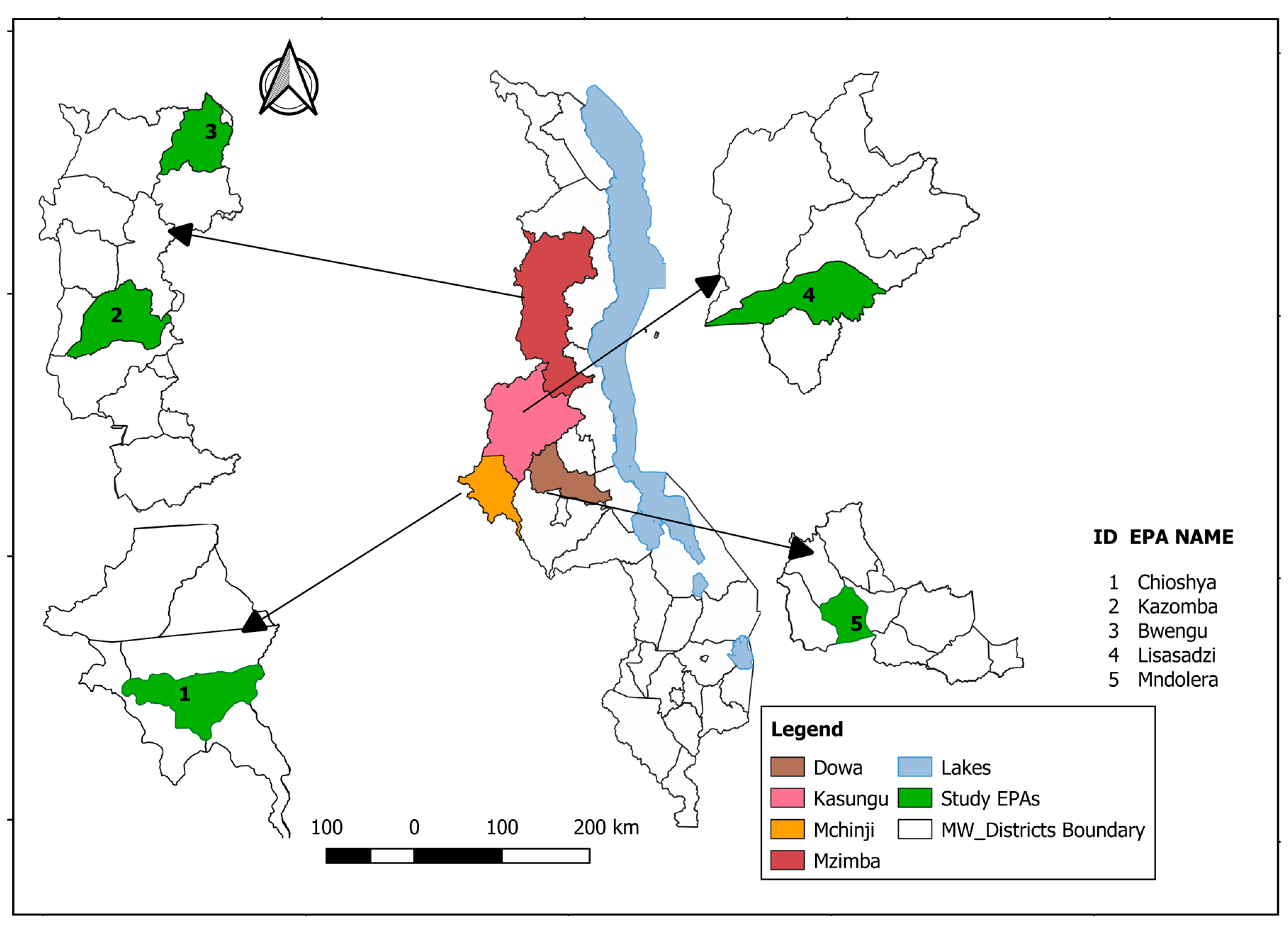
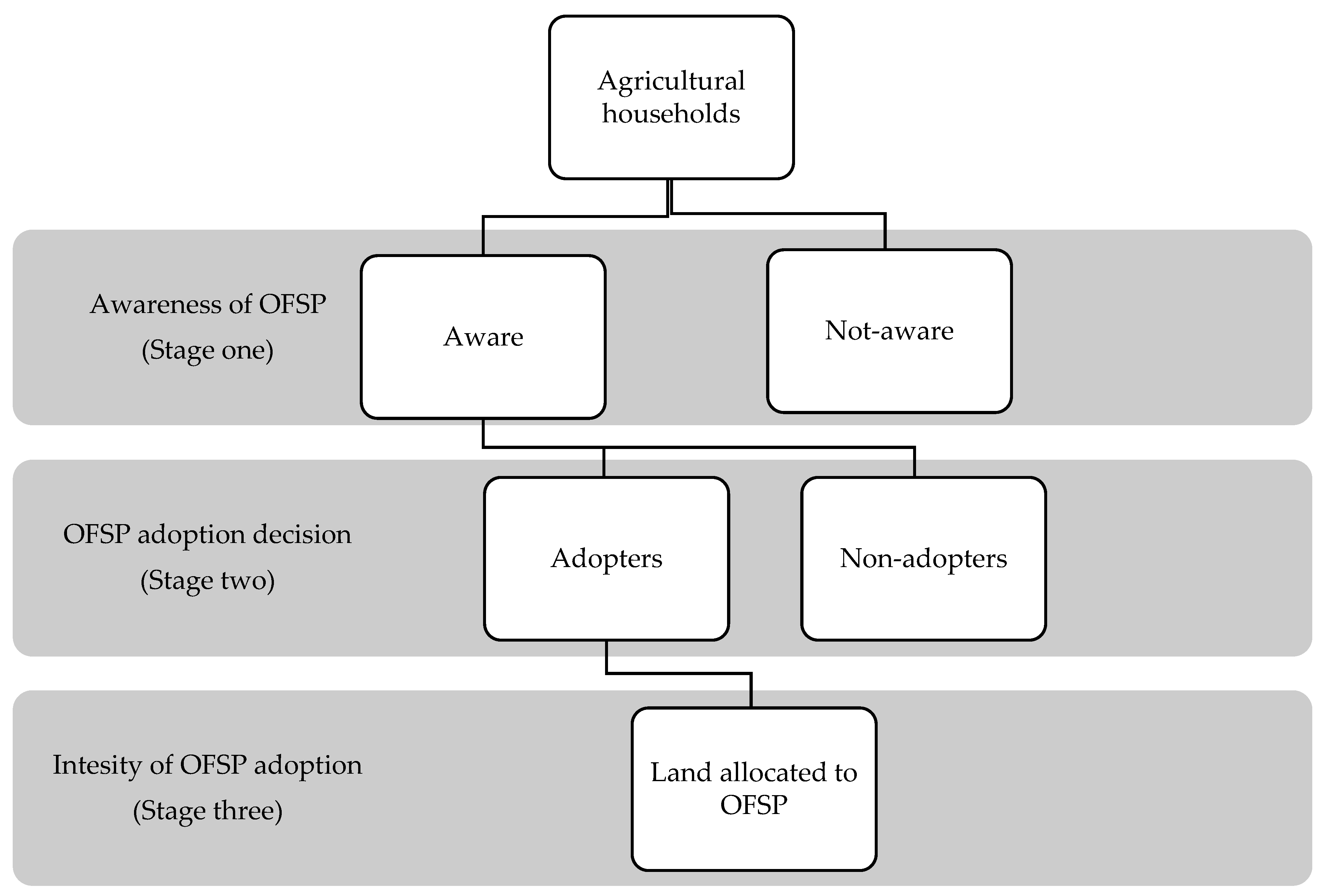
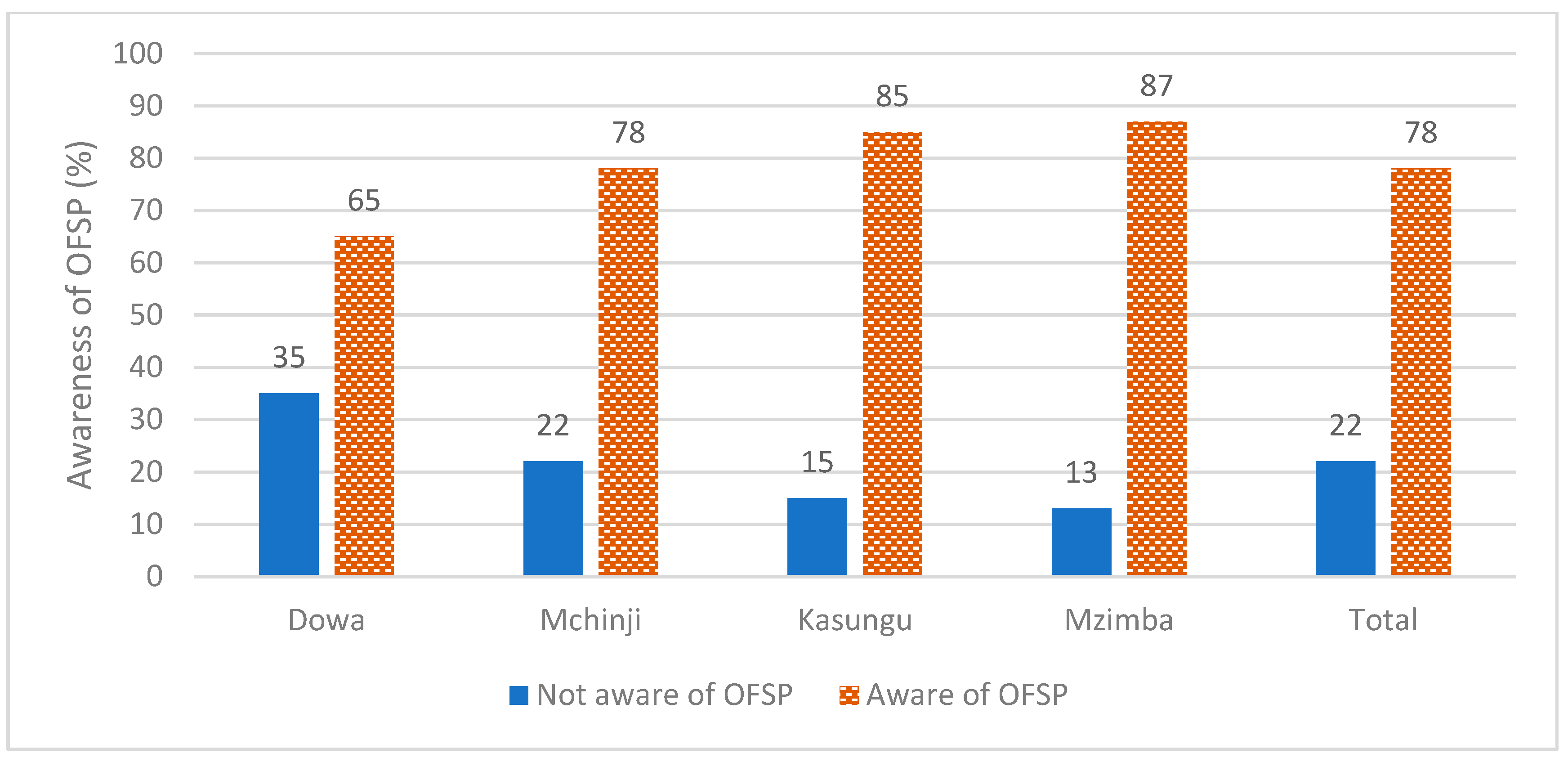
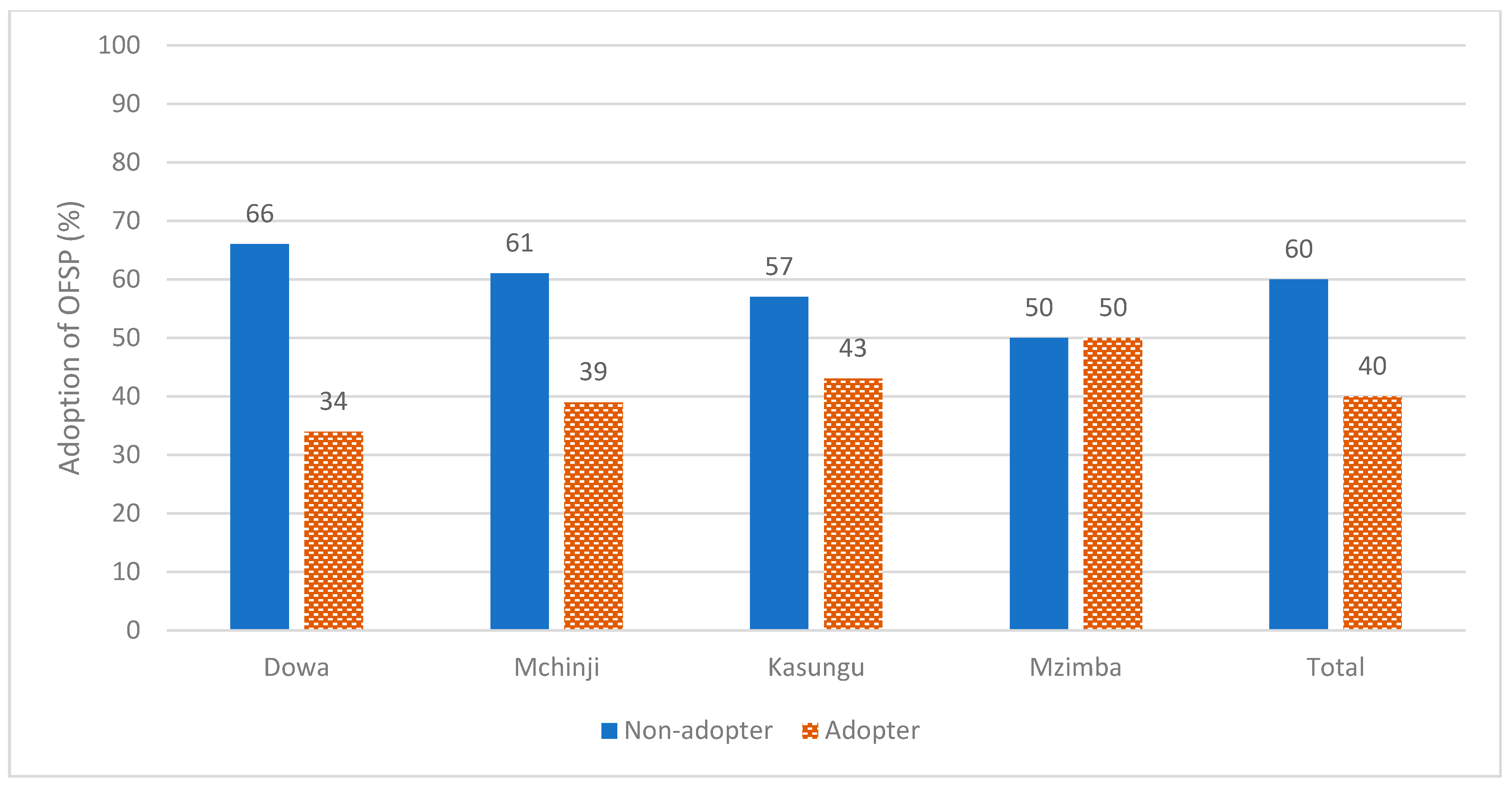
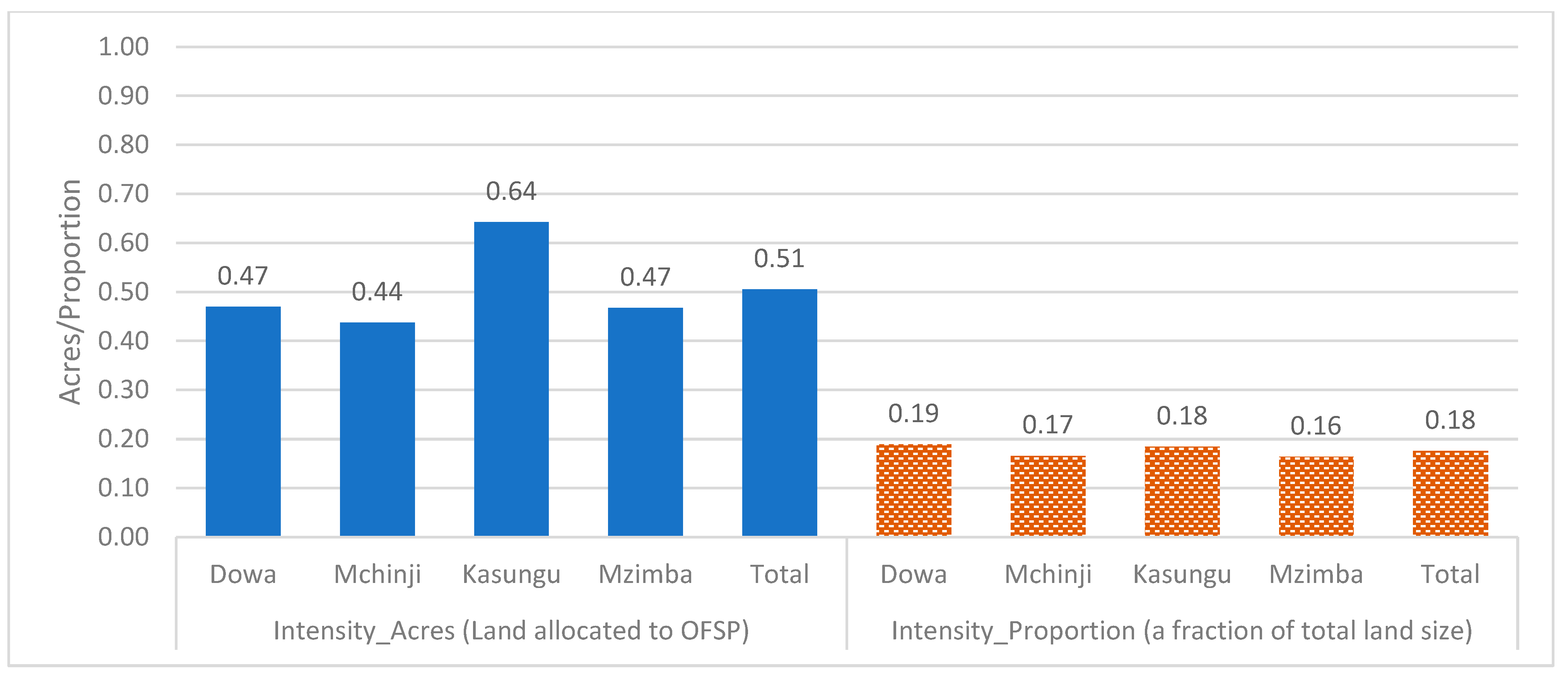
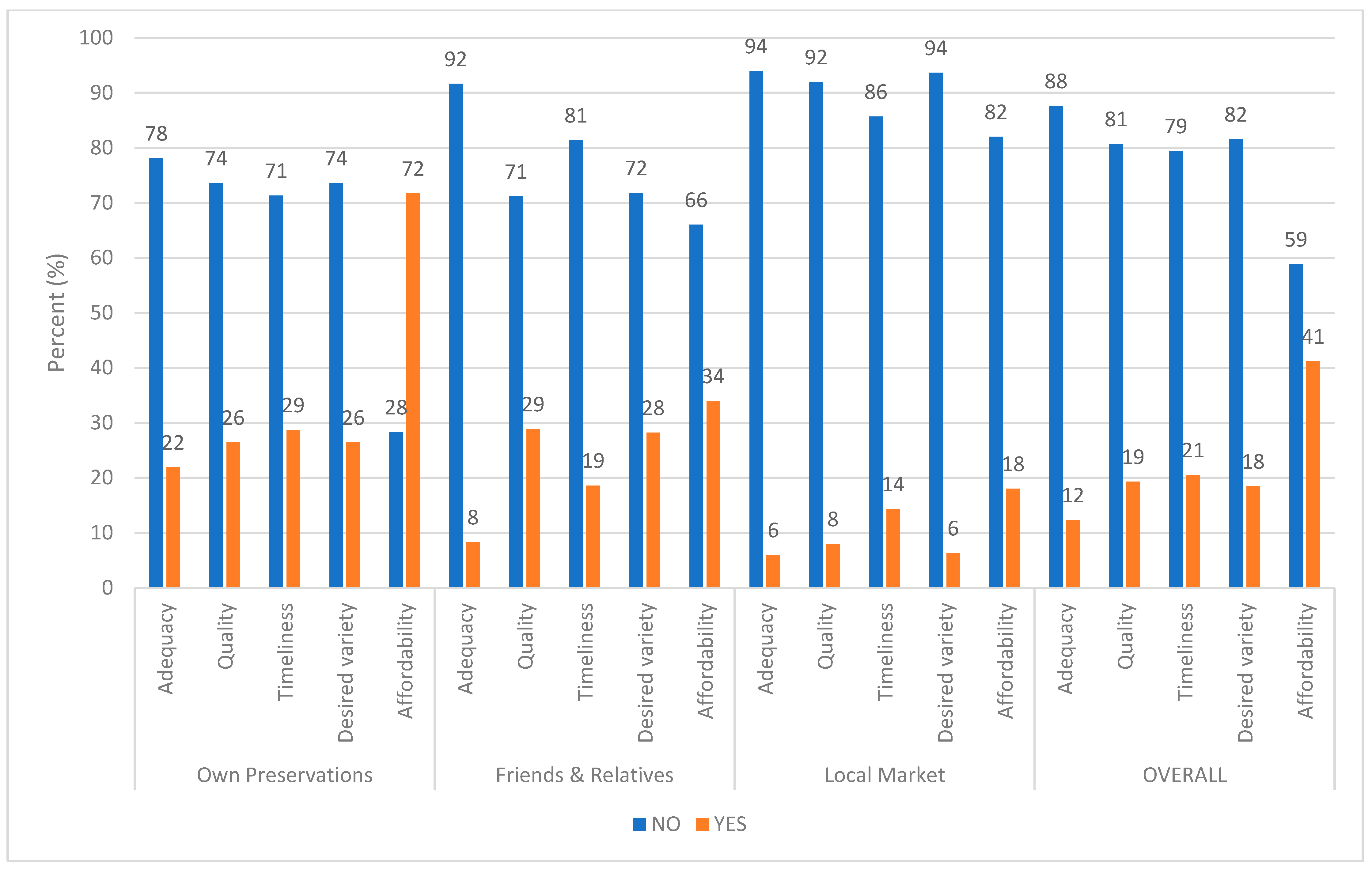
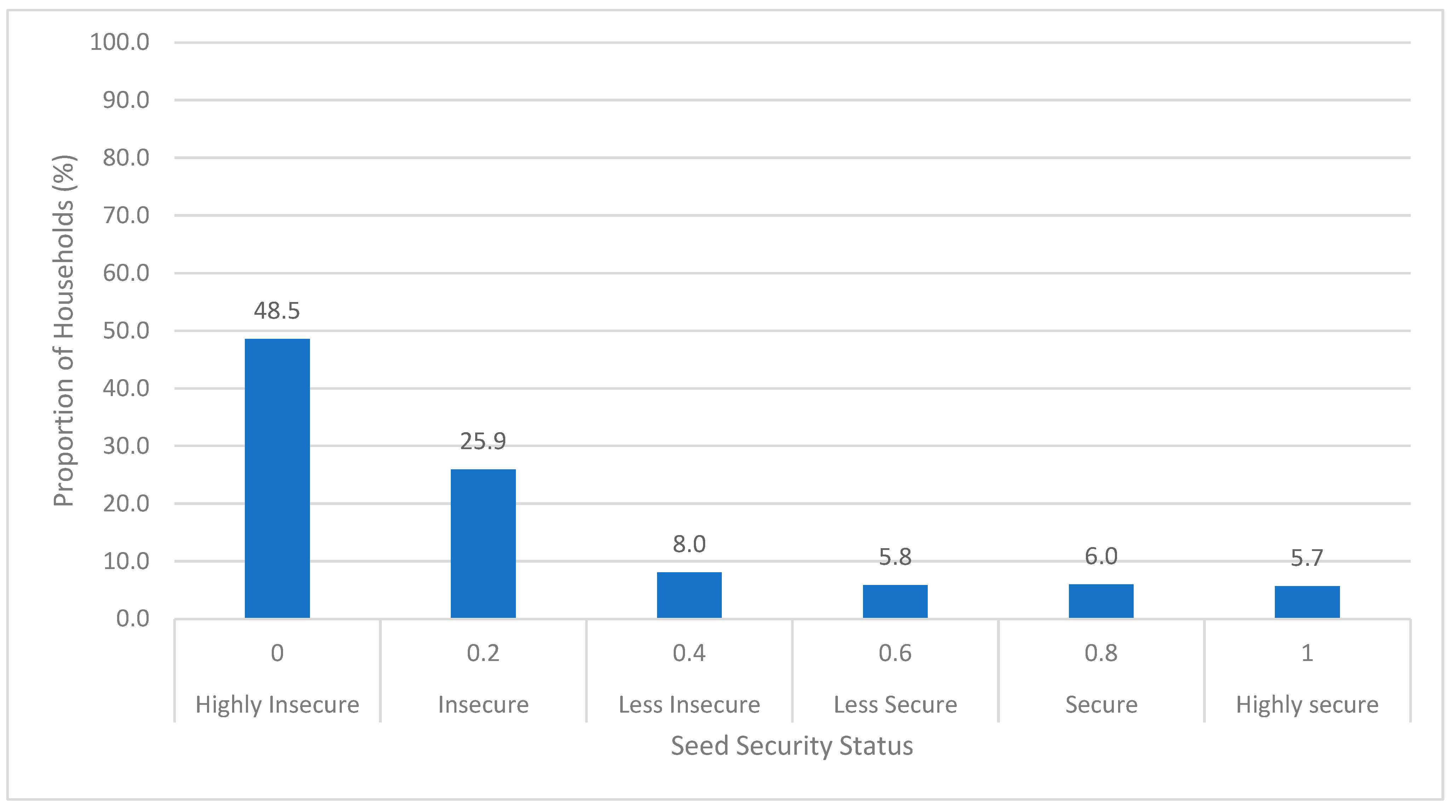
| Variable | Expected Sign of Influence | Reference | ||
|---|---|---|---|---|
| Y1 | Y2 | Y3 | ||
| Dependent Variables | ||||
| Awareness (Y1) (1 = Aware, 0 = Otherwise) | [47,64] | |||
| Adoption (Y2) (1 = Adopted, 0 = Otherwise) | [47,65,66,67,68] | |||
| Intensity of Adoption (Y3) (Land in acres or as a proportion of total land size) | [51,69,70] | |||
| Independent Variables | ||||
| Age of HH Head (years) | [66,71] | |||
| Education of HH Head (years) | [65,66] | |||
| Gender of HH Head (1 = male, 0 = female) | [65,71] | |||
| Years of farming experience (years) | [65,72] | |||
| Household size (Number of household members) | [65,66] | |||
| Household Off-farm Income | [40] | |||
| Land ownership (acres) | [65] | |||
| Purpose for cultivating sweet potato (1 = Own consumption 2 = Selling 3 = Both) | [73] | |||
| Existing Sources of Vines (1 = Own preservation 2 = Friends/Relatives 3 = Bought 4 = NGO Project 5 = Government) | [24,25,30,31] | |||
| Participation in nutrition sensitive project (1 = Yes, 0 = Otherwise) | [69] | |||
| Access to extension (1 = Yes, 0 = No) | [47,65] | |||
| Access to credit (1 = Yes, 0 = No) | [43,72,74] | |||
| Farmer clubs/association membership (1 = Yes, 0 = Otherwise) | [65,75] | |||
| Distance to sweet potato plot (kilometers) | [69] | |||
| Taste attribute (1 = if farmer considered taste, 0 = if otherwise) | [66] | |||
| District | Non-Adopters | Adopters | ||
|---|---|---|---|---|
| Not Aware (%) | Aware (%) | Not Aware (%) | Aware (%) | |
| Dowa | 49 | 51 | 9 | 91 |
| Mchinji | 31 | 69 | 5 | 95 |
| Kasungu | 26 | 74 | 1 | 99 |
| Mzimba | 27 | 73 | 0 | 100 |
| Pooled | 35 | 65 | 4 | 96 |
| Source of Vines | Seed Source Type | Total | ||||
|---|---|---|---|---|---|---|
| Formal | Informal | |||||
| Freq. | % | Freq. | % | Freq. | % | |
| Own vines | 0 | 0 | 265 | 36.75 | 265 | 36.75 |
| Friends/Relatives | 0 | 0 | 156 | 21.64 | 156 | 21.64 |
| Bought from local market | 0 | 0 | 300 | 41.61 | 300 | 41.61 |
| NGO/Project | 0 | 0 | 0 | 0 | 0 | 0 |
| Government/extension | 0 | 0 | 0 | 0 | 0 | 0 |
| Total | 0 | 0 | 721 | 100 | 721 | 100 |
| Variable | Pooled (n = 721) | Adopters (n = 291) | Non-Adopters (n = 430) | Significance | |||
|---|---|---|---|---|---|---|---|
| Mean | Std. dev. | Mean | Std. dev. | Mean | Std. dev. | p-Value | |
| Sex of HH Head (1 = Male, 0 = Female) | 0.78 | 0.41 | 0.79 | 0.41 | 0.77 | 0.42 | 0.611 |
| Age of HH Head (Years) | 44.33 | 14.70 | 46.21 | 14.43 | 43.07 | 14.77 | 0.005 *** |
| Marital status of HH Head (1 = Married, 0 = Otherwise) | 0.76 | 0.43 | 0.76 | 0.43 | 0.76 | 0.43 | 0.911 |
| Main Occupation of HH Head (1 = Farming, 0 = Otherwise) | 0.90 | 0.29 | 0.92 | 0.28 | 0.90 | 0.31 | 0.321 |
| Education of HH Head (Years) | 6.01 | 3.69 | 6.57 | 3.84 | 5.63 | 3.54 | 0.001 *** |
| Household size (Number of persons) | 5.25 | 1.88 | 5.34 | 1.70 | 5.19 | 1.99 | 0.2942 |
| TV/radio (1 = Present, 0 = Otherwise) | 0.30 | 0.46 | 0.34 | 0.47 | 0.28 | 0.45 | 0.085 * |
| Project participation (1 = Yes, 0 = No) | 0.47 | 0.50 | 0.66 | 0.48 | 0.35 | 0.48 | 0.000 *** |
| Total land size (Acres) | 3.04 | 2.09 | 3.48 | 2.33 | 2.74 | 1.86 | 0.000 *** |
| Farmer Club membership (1 = Member, 0 = Otherwise) | 0.61 | 0.49 | 0.72 | 0.45 | 0.54 | 0.50 | 0.000 *** |
| Access to credit (1 = Yes, 0 = No) | 0.13 | 0.34 | 0.18 | 0.38 | 0.10 | 0.31 | 0.004 *** |
| Annual off farm income (MWK′000) | 314 | 412 | 331 | 438 | 303 | 393 | 0.376 |
| Access to extension (1 = Yes, 0 = No) | 0.49 | 0.50 | 0.65 | 0.48 | 0.39 | 0.49 | 0.000 *** |
| Variable | Awareness | Adoption | Intensity |
|---|---|---|---|
| Probit (n = 721) | Probit (n = 561) | Lognormal (n = 291) | |
| ME (SE) | ME (SE) | Coeff. (SE) | |
| District (Dowa) | |||
| Mchinji (1 = Yes) | 0.1121 *** | −0.0286 | −0.0291 |
| (0.0390) | (0.0538) | (0.0819) | |
| Kasungu (1 = Yes) | 0.1284 *** | −0.0936 | 0.1659 * |
| (0.0432) | (0.0585) | (0.0994) | |
| Mzimba (1 = Yes) | 0.1577 *** | −0.0208 | 0.0235 |
| (0.0448) | (0.0646) | (0.1179) | |
| Sex of HH Head (1 = Male) | 0.0666 * | 0.0088 | −0.0195 |
| (0.0344) | (0.0507) | (0.0823) | |
| Occupation (1 = Farming) | 0.1012 ** | − | − |
| (0.0446) | |||
| Farming experience (Years) | 0.0012 | 0.0030 * | −0.0010 |
| (0.0012) | (0.0016) | (0.0028) | |
| Education Level of HH Head (Years) | 0.0024 | 0.0068 | 0.0160 |
| (0.0046) | (0.0063) | (0.0101) | |
| Household Size (Persons) | −0.0065 | −0.0105 | −0.0089 |
| (0.0082) | (0.0119) | (0.0199) | |
| Household off-farm Income | −0.0000 | 0.0001 ** | 0.0000 |
| (0.0000) | (0.0000) | (0.0001) | |
| Nutrition Sensitive Project (1 = Yes) | 0.1687 *** | 0.1492 *** | −0.1752 ** |
| (0.0306) | (0.0409) | (0.0745) | |
| Availability of a Vine Multiplier (1 = Yes) | 0.1229 * | 0.1576 ** | 0.0534 |
| (0.0731) | (0.0696) | (0.1190) | |
| Purpose (Consumption) | |||
| Selling (1 = Yes) | 0.0015 | −0.0760 | 0.7702 *** |
| (0.0916) | (0.1313) | (0.3197) | |
| Both consumption and selling (1 = Yes) | 0.0122 | 0.0071 | 0.2184 *** |
| (0.0297) | (0.0431) | (0.0689) | |
| Group Membership (1 = Yes) | 0.0026 | 0.0917 ** | − |
| (0.0321) | (0.0447) | ||
| Access to credit (1 = Yes) | 0.0931 ** | 0.0314 | 0.1183 |
| (0.0448) | (0.0554) | (0.0864) | |
| Access to extension (Times of contact) | 0.0132 | 0.0294 ** | 0.0405 * |
| (0.0095) | (0.0119) | (0.0208) | |
| Sources of Vines (Own) | |||
| Friends/Relatives (1 = Yes) | 0.0798 ** | 0.1026 ** | −0.2678 *** |
| (0.0364) | (0.0511) | (0.0913) | |
| Bought from market (1 = Yes) | −0.0525 * | 0.0084 | −0.1720 * |
| (0.0341) | (0.0471) | (0.0876) | |
| Total land size (Acres) | 0.0129 | 0.0109 | 0.0533 *** |
| (0.0080) | (0.0099) | (0.0197) | |
| Distance to sweet potato farm plot (Kilometres) | 0.0410 *** | −0.0420 *** | 0.0289 |
| (0.0097) | (0.0143) | (0.0211) | |
| Soil fertility Perception (1 = Fertile) | −0.1038 *** | 0.0934 ** | −0.0499 |
| (0.0323) | (0.0428) | (0.0850) | |
| Taste | − | 0.1368 ** | 0.2665 *** |
| (0.0605) | (0.0981) | ||
| Constant | − | − | −1.1561 *** |
| (0.1892) |
Disclaimer/Publisher’s Note: The statements, opinions and data contained in all publications are solely those of the individual author(s) and contributor(s) and not of MDPI and/or the editor(s). MDPI and/or the editor(s) disclaim responsibility for any injury to people or property resulting from any ideas, methods, instructions or products referred to in the content. |
© 2023 by the authors. Licensee MDPI, Basel, Switzerland. This article is an open access article distributed under the terms and conditions of the Creative Commons Attribution (CC BY) license (https://creativecommons.org/licenses/by/4.0/).
Share and Cite
Kaphaika, C.S.; Katengeza, S.P.; Pangapanga-Phiri, I.; Chambukira, M.H. More Interventions, Low Adoption: To What Extent Are the Existing Seed Sources to Blame? The Case of Orange Fleshed Sweet Potato in Central and Northern Malawi. Sustainability 2023, 15, 14390. https://doi.org/10.3390/su151914390
Kaphaika CS, Katengeza SP, Pangapanga-Phiri I, Chambukira MH. More Interventions, Low Adoption: To What Extent Are the Existing Seed Sources to Blame? The Case of Orange Fleshed Sweet Potato in Central and Northern Malawi. Sustainability. 2023; 15(19):14390. https://doi.org/10.3390/su151914390
Chicago/Turabian StyleKaphaika, Chrispin Sunganani, Samson Pilanazo Katengeza, Innocent Pangapanga-Phiri, and Madalitso Happy Chambukira. 2023. "More Interventions, Low Adoption: To What Extent Are the Existing Seed Sources to Blame? The Case of Orange Fleshed Sweet Potato in Central and Northern Malawi" Sustainability 15, no. 19: 14390. https://doi.org/10.3390/su151914390
APA StyleKaphaika, C. S., Katengeza, S. P., Pangapanga-Phiri, I., & Chambukira, M. H. (2023). More Interventions, Low Adoption: To What Extent Are the Existing Seed Sources to Blame? The Case of Orange Fleshed Sweet Potato in Central and Northern Malawi. Sustainability, 15(19), 14390. https://doi.org/10.3390/su151914390






